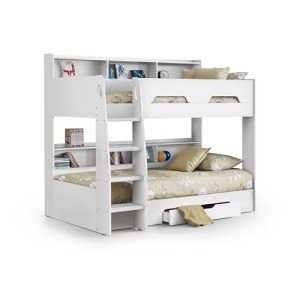Some Wisdom On Bunk Bed For Kids From A Five-Year-Old
The Ultimate Guide to Bunk Beds for Kids: Safety, Styles, and Solutions
Bunk beds have long been a popular option among moms and dads seeking to enhance space in their children's bedrooms. With advantages that exceed their compact design, bunk beds use an enjoyable and practical sleeping arrangement while encouraging sibling bonding and cultivating imagination. In this thorough guide, we explore different elements of bunk beds for kids, consisting of security factors to consider, different styles available, and suggestions for choosing the right one for your family.
Why Choose Bunk Beds?
Bunk beds are created to stack one bed on top of another, utilizing vertical space to produce more space for play and storage. They are especially useful for families with multiple kids or limited bed room space. Furthermore, they provide an adventurous sleeping environment that kids often delight in.
Secret Advantages of Bunk Beds:
- Space-saving style: Ideal for little rooms or shared areas.
- Economical: Often more affordable than buying two different beds.
- Encourages social interaction: Promotes bonding amongst brother or sisters or good friends.
- Flexible options: Available in different designs and setups to suit any space style.
Safety First: Essential Considerations
When selecting a bunk bed for kids, security should be the leading priority. The following features are vital for making sure a safe sleeping environment:
Important Safety Features:
- Sturdy Construction: Ensure that the bed frame is made from resilient products such as solid wood or metal.
- Guardrails: Bunk beds should have guardrails on both sides of the upper bunk to prevent falls.
- Ladder Safety: A sturdy, built-in ladder or stairs with anti-slip rungs is important for safe access to the leading bunk.
- Weight Limit: Check the manufacturer's weight limitation capability for both the leading and bottom bunk.
- Bed mattress Size: Use the proper mattress size as defined by the bed manufacturer to make sure a snug fit within the bed frame.
Security Tips for Parents:
- Monitor Sleep Habits: Teach kids the importance of not using or jumping off the bunk beds.
- Age Appropriateness: Generally, the upper bunk is appropriate for children aged 6 and older.
- Routine Inspections: Periodically check for any loose bolts, screws, or structural damage.
Styles of Bunk Beds
Bunk beds can be found in a variety of designs, enabling moms and dads to pick one that matches their child's space design while conference specific needs. Below are some popular styles:
Popular Bunk Bed Styles:
- Traditional Bunk Beds: Simple and classic styles made from wood or metal without any additional functions.
- Loft Beds: Features a raised leading bunk with space underneath for a desk, play location, or extra storage.
- L-Shaped Bunk Beds: Arranged in an L-shape, often perfect for corner areas and can have extra storage choices.
- Twin over Full Bunk Beds: A twin bed on leading and a larger full-sized bed on the bottom, accommodating kids or teens of numerous ages.
- Triple Bunk Beds: Designed to fit 3 beds in a single footprint, perfect for bigger families or sleepovers.
A Comparison of Bunk Bed Styles
Bunk Bed Style
Description
Best For
Conventional
Traditional style with 2 stacked beds
Standard bed room setups
Loft Bed
Raised bed with usable space below
Homework or play locations
L-Shaped
Bunk beds organized in an L-shape
Corner areas
Twin over Full
Twin bed on top, full bed below
Various age siblings
Triple Bunk
3 stacked beds
Large households or pajama parties
Selecting the Right Bunk Bed
When searching for the best bunk bed, consider the list below elements to ensure you make an informed decision:
Key Factors to Consider:
- Room Size: Measure the space dimensions to identify the suitable size and height of the bunk bed.
- Child's Age: Consider the age of your child(ren) when choosing a design and security functions.
- Performance: Think about how much storage or play space you require and whether the bunk bed ought to serve extra functions.
- Spending plan: Set a budget plan that includes not only the bunk bed however also the needed bed mattress and devices like bedding or safety gates.
FAQs About Bunk Beds for Kids
1. What age is suitable for a kid to sleep in the leading bunk?
Typically, kids aged 6 and older should be able to safely sleep in the top bunk, though you ought to always consider your child's maturity level.
2. Are bunk beds safe for young children?
It is not advisable for toddlers or very young kids to sleep in the leading bunk due to the risk of falling.
3. How do I keep the bunk bed?
Examine the bed routinely for any signs of wear and tear, tightening up screws, and cleaning up the bed mattress to make sure extended security and durability.
4. Can I transform a bunk bed into two separate beds?
Lots of bunk beds are designed to be convertible, enabling you to separate the beds when required. Examine the maker's requirements before acquiring.
5. How can my explanation make the most of space in a bunk bed room?
Make use of under-bed drawers, racks, or lofted designs to develop additional storage solutions in a room with a bunk bed.
Bunk beds provide a wonderful blend of fun, performance, and space-saving utility, making them an ideal option for young households. By considering security functions, different styles, and useful elements such as space size and age suitability, parents can select the best bunk bed for their kid's needs. With the right choice, bunk beds can change a bed room into a magical space that motivates play, creativity, and bonding among brother or sisters. Constantly remember to prioritize security and maintenance to maximize this unique sleeping plan.
